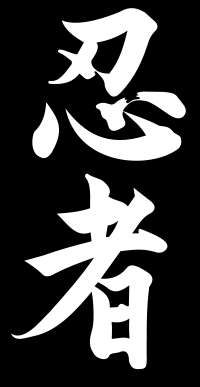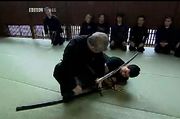Ninjutsu
 |
|
|---|---|
| The kanji for "ninja". | |
| Also known as | Ninjitsu; Ninpō |
| Focus | Multi-discipline |
| Hardness | Non-competitive |
| Country of origin | |
| Creator | Ninjas |
| Parenthood | Historic |
Ninjutsu (忍術) sometimes used interchangeably with the term ninpō (忍法) is the martial art, strategy, and tactics of unconventional warfare and guerrilla warfare as well as the art of espionage purportedly practiced by the shinobi (commonly known outside of Japan as ninja).[1]
While there are several styles of "modern ninjutsu," the historicity and lineage of these styles is disputed. [2]
Contents |
Etymology
The main character nin (忍) is a phono-semantic compound composed of two greater characters. The upper character ha or toh (刃) is the phonetic indicator; its meaning of "edge of the sword" is therefore irrelevant here. The lower character kokoro or shin (心) means "heart" or "soul". The compound means "stealth", "secrecy", "endurance", "perseverance", and "patience".[3] Jutsu (術) means "art" or "technique". Hō (法) meaning "knowledge", "principle", "law" or "system" when found with the prefix "nin" carries the meaning of ninja arts, higher order of ninjutsu.
History
Ninjutsu was developed by groups of people mainly from the Iga Province Iga Ryu Ninjutsu and Kōka, Shiga of Japan. Throughout history the shinobi have been seen as assassins, scouts and spies. They are mainly noted for their use of stealth and deception. Throughout history many different schools (ryū) have taught their unique versions of ninjutsu. An example of these is the Togakure-ryū. This ryū was developed after a defeated samurai warrior called Daisuke Togakure escaped to the region of Iga. Later he came in contact with the warrior-monk Kain Doshi who taught him a new way of viewing life and the means of survival (ninjutsu).[4].
Ninjutsu was developed as a collection of fundamental survivalist techniques in the warring state of feudal Japan. The ninja used their art to ensure their survival in a time of violent political turmoil. Ninjutsu included methods of gathering information, and techniques of non-detection, avoidance, and misdirection. Ninjutsu can also involve training in disguise, escape, concealment, archery, and medicine.[5]
Skills relating to espionage and assassination were highly useful to warring factions in feudal Japan. Because these activities were seen as dishonorable, Japanese warriors hired people who existed below Japan's social classes to perform these tasks. These persons were literally called "non-humans" (非人 hinin).[6] At some point the skills of espionage became known collectively as ninjutsu, and the people who specialized in these tasks were called shinobi no mono.
18 Skills

According to Bujinkan[7] members Ninja Jūhakkei, the eighteen disciplines (jūhakkei < jūhachi-kei) were first stated in the scrolls of Togakure-ryū. Subsequently they became definitive for all ninjutsu schools by providing total training of the warrior in various fighting arts and agarter.
Ninja jūhakkei was often studied along with Bugei Jūhappan (the "18 samurai fighting art skills"). Though some are used in the same way by both samurai and ninja, other techniques were used differently by the two groups.
The 18 disciplines are:[8]
- Seishinteki kyōyō (spiritual refinement)
- Taijutsu (unarmed combat)
- Kenjutsu (sword techniques)
- Bōjutsu (stick and staff techniques)
- Sōjutsu (spear techniques)
- Naginatajutsu (naginata techniques)
- Kusarigamajutsu (kusarigama techniques)
- Shurikenjutsu (throwing weapons techniques)
- Kayakujutsu (pyrotechnics)
- Hensōjutsu (disguise and impersonation)
- Shinobi-iri (stealth and entering methods)
- Bajutsu (horsemanship)
- Sui-ren (water training)
- Bōryaku (tactics)
- Chōhō (espionage)
- Intonjutsu (escaping and concealment)
- Tenmon (meteorology)
- Chi-mon (geography)
The name of the discipline of Taijutsu (体術), literally means "body skill" or "body art". Historically, the word taijutsu is often in Japan used interchangeably with jujutsu (as well as many other terms) to refer to a range of grappling skills. The term is also used in the martial art of aikido to distinguish the unarmed fighting techniques from other (e.g. stick fighting) techniques. In ninjutsu, especially since the emergence of the Ninja movie genre in the 80s, it is also used to avoid the undesired bravado of explicitly referring to "ninja" combat techniques.
Modern schools
There are a number of modern schools of martial arts self-identifying as practicing ninjutsu. Neo-ninja is a term that refers to modern martial arts schools which claim to teach elements of the historic ninja of Japan, or base their school's philosophy upon traits attributed to the historic ninja of Japan.[9]
Weapons & Equipment
The following tools may not be exclusive to the Ninja, but they are commonly associated with the practice of Ninjutsu.
- Kaginawa, or Grappling hook (facilitates stealth entry and Hojojutsu)
- Hanbo (small staff)
- Kama (derived from the farming blade into a weapon)
- Katana (traditional samurai sword or long sword)
- Kunai (multi-purpose tool)
- Kusarigama and Kyoketsu shoge (composite blade weapons)
- Manriki, Manriki-gusari and Kusarifundo (chain weapons)
- Ninjato (disguised short sword)
- Shuriken ("throwing stars" or darts)
- Tachi (slung sword)
- Tanto (dagger)
- Tekagi-shuko and Neko-te ("claw" weapons)
See also
- Kunoichi
- Neo-ninja
Notes
- ↑ Hayes, Stephen. “The Ninja and Their Secret Fighting Art.” ISBN 0804816565, Tuttle Publishing, 1990
- ↑ Skoss, Diane (ed.); Beaubien, Ron; Friday, Karl (1999). "Ninjutsu: is it koryu bujutsu?". Koryu.com. http://koryu.com/library/ninjutsu.html. Retrieved 2007-01-01.
- ↑ Hayes, Stephen. "The Mystic Arts of the Ninja." 1985: 2
- ↑ Hayes, Stephen. “The Ninja and Their Secret Fighting Art.” 1981: 18-21
- ↑ Hatsumi, Masaaki. “Ninjutsu: History and Tradition.” June 1981
- ↑ Draeger, Donn F. (1973, 2007). Classical Bujutsu: The Martial Arts and Ways of Japan. Boston, Massachusetts: Weatherhill. pp. 84–85. ISBN 978-0-8348-0233-9.
- ↑ "Bujinkan Dojo - Soke Masaaki Hatsumi". http://www.bujinkan.com. Retrieved 2007-06-05.
- ↑ "Togakure Ryu Ninjutsu". http://www.ninjutsu.ws/ninjutsu/togakure-ryu-ninjutsu. Retrieved 2008-01-30.
- ↑ Martial talk discussion The term "American Ninjutsu" [1] is also used commonly with neo-ninja [2]
References
- Essence of Ninjutsu by Masaaki Hatsumi (ISBN 0-8092-4724-0)
- Notable American Martial Artists by Callos, Tom. Black Belt Magazine (May 2007) 72-73
- Ninjutsu: History and Tradition by Masaaki Hatsumi (ISBN 0-86568-027-2)
- Ninpo: Wisdom for Life by Masaaki Hatsumi (ISBN 1-58776-206-4 or 0972773800)
- The Ninja and their Secret Fighting Art by Stephen K. Hayes (ISBN 0-8048-1656-5)
- Wingspan: Culture-Society-People in Japan, Where Have All the Ninja Gone? by Thomas Dillon (September, 2007 No.459)
- Historical group image editorial staff compilation by Kuroi Hiroshi optical work (ISBN 978-4-05-604814-8)
- The Last of the Ninja by Thomas Dillon
- Secret Guide to Making Ninja Weapons, by Yamashiro Toshitora, Butokukai Press, 1986, ISBN 978-99942-913-1-1
- A Story of Life, Fate, and Finding the Lost Art of Koka Ninjutsu in Japan by Daniel DiMarzio (ISBN 978-1-4357-1208-9)
- 'Techniques that made ninjas feared in 15th-century Japan still set the standard for covert ops.' Bertrand, John. (2006). 23(1), pp. 12–19. Retrieved on July 11, 2008 from Academic Search Premier database.
- Secrets from the Ninja Grandmaster (Rev. Ed.). Hayes, Stephen K. and Masaaki Hatsumi. (2003). Boulder, Colorado; Paladin Press.
- The Ninja: Ancient Shadow Warriors of Japan by Kacem Zoughari, PhD. Tuttle Publishing (2010). (ISBN 0-8048-3927-1)
External links
|
||||||||||||||||||||
|
||||||||||||||||